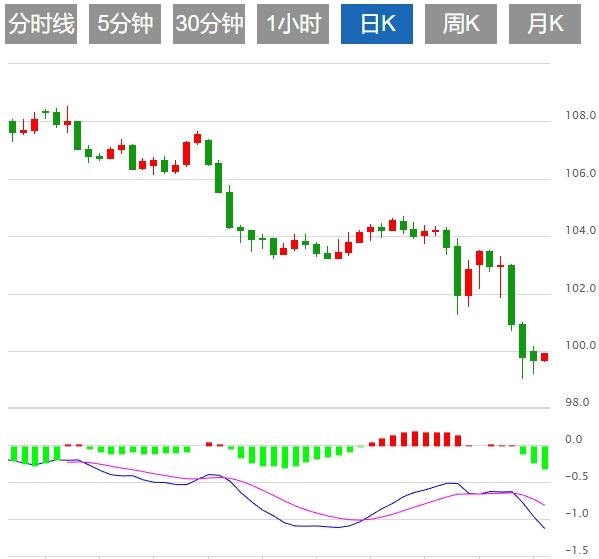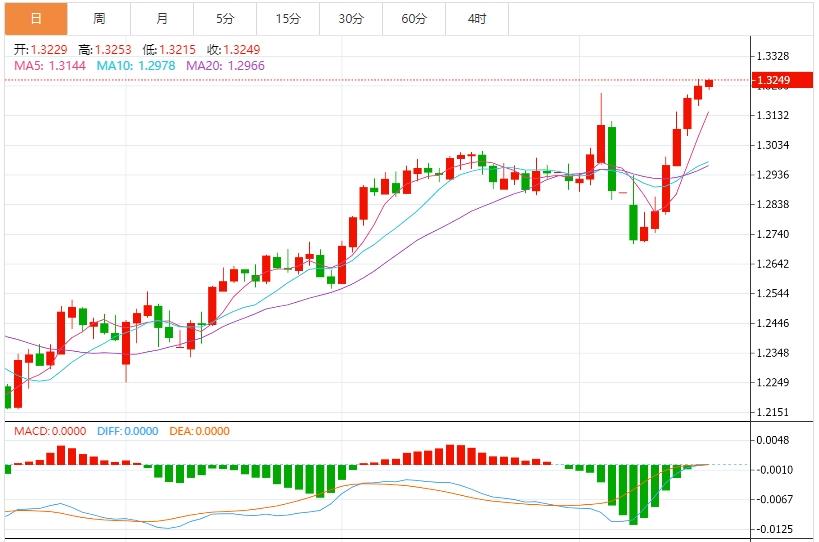Wonderful Introduction:
A person's happiness may be false, and a group of people's happiness cannot tell whether it is true or false. They squandered their youth and wished they could burn it all, and that posture was like a carnival before the end of the world.
Hello everyone, today Avatrade Aihua Foreign Exchange will bring you "[Aihua Foreign Exchange]: The US dollar index fluctuates below the 100 mark, and the market pays attention to the initial data of the United States". Hope it will be helpful to you! The original content is as follows:
On Thursday, the US dollar index hovered around 99.50. This trading day will usher in the European Central Bank interest rate resolution, and the market is generally expected to fall by 25 basis points; in addition, changes in the number of initial unemployment benefits in the United States, the initial value of the annualized total construction permits in the United States in March, and the total annualized number of new houses in the United States in March will be released. Investors need to pay attention. Friday is the Good Friday holiday, and investors should also beware of the position adjustments of brokers before the holiday.
Analysis of major currencies
Dollar: As of press time, the U.S. dollar index hovers around 99.48, and traders continue to bet on the Fed's interest rate cut this year after Fed Chairman Jerome Powell said that the central bank is in a good position to wait for greater clarity before making changes in policy stance. Judging from the daily chart, the US dollar index is in a larger-level downward channel. The price has been falling from the high point of 110.1699, forming a clear downward trend line. Recently, the price has fallen below the 100 integer mark and is currently trading around 99.50. The daily MACD indicator shows that the DIFF is -1.3009, the DEA is -0.9727, the MACD value is -0.6564, and the bar chart expands, confirming the acceleration of the medium-term downward trend. The RSI indicator is located at the low level of 26.5350 and is already oversold, suggesting a possible technical rebound. However, from the perspective of trend integrity, unless the price can re-establish the downward trend line of 100.3280, the medium-term short pattern will be difficult to reverse.



1. Powell: The Federal Reserve is ready to provide US dollar liquidity at any time
Feder Chairman Powell said Wednesday that the Federal Reserve is ready to provide US dollar liquidity if necessary through its swap quotas with other central banks. Powell said in a question at an event at the Chicago Economic Club, "We want to ensure the availability of the dollar." He said, "The reason we do this is that it is very beneficial to American consumers. Therefore, we will continue to do this because the dollar is part of the global reserve currency."
2. Powell: Don't expect the Fed to take action to save the market. Trump is changing every day./h3>
Feder Chairman Powell said on Wednesday that market expectations that the Fed would take action to calm the volatility could be wrong. When asked whether the Fed would intervene in response to the sharp decline in the stock market, Fed Chairman Powell said: "My answer is no, but I will give an explanation." Powell said at the meeting in Chicago: "I think the market is digesting the current situation, the market is coping with a lot of uncertainty, and that means volatility." Powell said that given the huge changes in the tariff system of US President Trump, it is understandable that the market will encounter difficulties. He also explained that it was difficult to know in real time what caused the trouble. Powell said: "I have had many experiences with major market volatility, such as bond markets. Usually people form an idea and look back two months later and find that the original view was avatradescn.completely wrong. Therefore, it is too early to determine what happened in the market now." At present, he pointed out that the market turmoil stems in part from hedge funds cutting leverage or debt, adding: "In the short term, you may continue to see market volatility."
3. The Bank of Canada says U.S. tariffs may drag down the Canadian economy into a deep recession
According to a forecast released by the Bank of Canada on Wednesday, if U.S. tariffs trigger a global trade war, Canada's inflation rate will climb and fall into a deep recession. The Bank of Canada has not released regular quarterly economic forecasts on the grounds of high uncertainty. Instead, it provides two possible scenarios. In the first case, most tariffs were cancelled through negotiations, and economic growth in Canada and globally weakened temporarily. Canada's inflation rate dropped to 1.5% in one year before returning to the bank's 2% target. The second scenario is that tariffs trigger a lasting global trade war. The Canadian economy fell into a severe recession, with inflation soaring above 3% in mid-2026 before returning to 2%. The Bank of Canada stressed that there are many other possible situations, which estimates GDP growth in the first quarter to be 1.8% annualized by 2.0% in the end of January.
4. U.S. retail sales surged in March because of buying cars before tariffs
U.S. retail sales soared in March as U.S. households increased their purchases before tariffs were imposed, but concerns about the economic outlook were hurting discretionary spending. Automakers reported a sharp increase in car sales in March, with some attributed it to buyers’ rush to “try to avoid tariffs.” Consumers are also stocking up other imported goods. Bank credit and debit card data show that high-income households continue to drive consumption, while low-income consumers are struggling. Disposable expenditures have been reduced, and these expenditures are mainly used in the service industry, the main engine of the economy.
5. UK inflation is falling, and the Bank of England is expected to cut interest rates multiple times in the future. HSBC economist Chris Hale said in a report that the decline in the UK's inflation rate in March is good news, especially as service prices drop, which is in line with the Bank of England's continued interest rate cuts in the future.The situation is consistent. The overall annual inflation rate fell to 2.6% from 2.8% in February, and the service industry inflation rate fell to 4.7% from 5.0%. He said the decline in the service industry is a particularly positive development, especially because it involves the entertainment and hospitality industry, rather than a one-time drag from a single industry. Developments since the U.S. announced the increase in tariffs show that the trend of inflation is still continuing. However, March data heralds a series of price increases, which could push overall inflation above 3% in April. However, Hale said the Bank of England is still likely to cut interest rates every quarter. Institutional View
1. Rabobank: Switzerland may be listed as a exchange rate manipulator by the U.S. Treasury
Raobank foreign exchange strategist Jane Foley said that if Switzerland interferes in the foreign exchange market to prevent the appreciation of the Swiss franc, Switzerland may be listed as a exchange rate manipulator by the U.S. Treasury. She said President Trump was "always moved" with countries that used intervention to weaken their own currencies. Generally speaking, the US Treasury "a little turned a blind eye" to Switzerland because the Swiss franc is overvalued. However, the U.S. Treasury will not like Switzerland's massive intervention, especially considering Switzerland's trade surplus. There is no doubt that this is a consideration when imposing tariffs on Switzerland.
2. Mitsubishi UF: The ECB will emphasize economic growth risks and is unlikely to send new signals
Mitsubishi UF's head of European economic research said in a report that the ECB's statement at its meeting on Thursday may contain "moderate dovish adjustments" that may emphasize the risks facing eurozone growth. Thursday's rate cut looks like a straightforward decision, and it may be the same in June. However, given the high uncertainty of trade policies and the timing of new fiscal stimulus, the ECB is unlikely to send too many new policy signals.在欧元区经济硬数据没有出现更明确转变的情况下,政策制定者可能希望保持很大的灵活性。 The ECB is expected to cut interest rates three more times this year, with deposit rates lowering to 1.75%.
3. Jefferies: The era of a strong dollar has reached its peak, and the dollar may weaken further
The dollar fell due to continued concerns that Trump's tariffs will affect the US economy. "People have questioned the credibility of the US exceptionalism and the dollar as a reserve currency," Jefferies economist Mohit Kumar said in a report. In the medium term, tariffs may reduce the reliability of the United States and investors will look for other destinations. He said the era of a strong dollar has reached its peak and the dollar may weaken further. Gold prices may benefit as central banks seek to reduce their dependence on the dollar.
The above content is all about "[Ihua Forex]: The US dollar index fluctuates below the 100 mark, and the market pays attention to the initial data of the United States". It is carefully avatradescn.compiled and edited by the Avatrade Forex editor. I hope you can have a transaction.Helped! Thanks for the support!
Only the strong know how to fight; the weak are not qualified to fail, but are born to be conquered. Step up to learn the next article!















